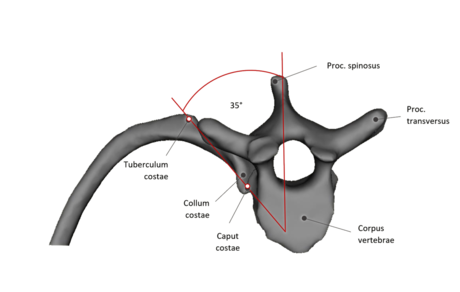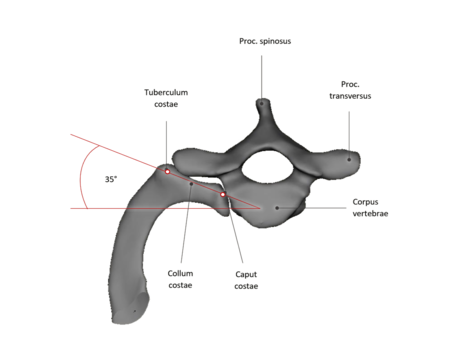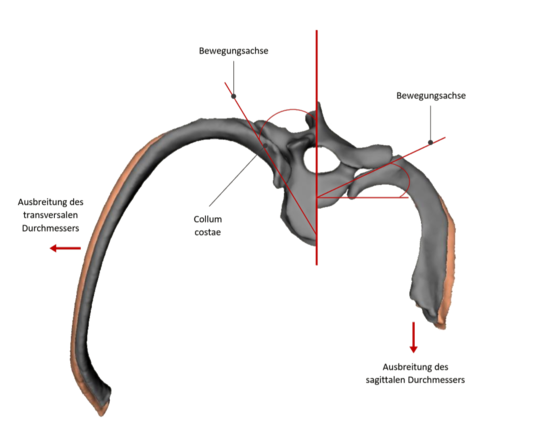Rippenwirbelgelenke und Thoraxbewegungen/en: Unterschied zwischen den Versionen
Becher (Diskussion | Beiträge) (Die Seite wurde neu angelegt: „===Vertebral arch joints (<i>Articulatio zygapophysialis</i>)===“) |
Becher (Diskussion | Beiträge) (Die Seite wurde neu angelegt: „'''Exercises''' back to the trunk wall“) |
||
| (11 dazwischenliegende Versionen desselben Benutzers werden nicht angezeigt) | |||
| Zeile 26: | Zeile 26: | ||
<br> | <br> | ||
| − | + | The connection between the individual vertebral arches is known as the vertebral arch joint. They are real joints and form a functional unit with the intervertebral discs (<i>Disci intervertebrales</i>) and the spinal ligaments. In addition, they determine the directions of movement, which are inclined to different degrees against the horizontal and vertical, depending on the spinal column section. The movement is always parallel to the joint surfaces. | |
| − | + | At the edges of the joint surfaces the '''joint capsules''' originate, which are often grown together with the <i>Lig. flavum</i>. | |
| − | + | The joint capsules are differently formed, so they are rather wide and flaccid in the area of the cervical spine, but noticeably narrower in the thoracic and lumbar segments. | |
<div style="text-align: center"> | <div style="text-align: center"> | ||
| − | <b> | + | <b>Position of the joint surfaces of the vertebral arch joints in the different sections of the spine:</b> |
| − | | <!--[segmenter_snapshot wirbelbogen 2]--> | + | | <!--[segmenter_snapshot wirbelbogen 2]-->cervical spine<!--[/]--> | <!--[segmenter_snapshot wirbelbogen 0]-->thoracic spine<!--[/]--> | <!--[segmenter_snapshot wirbelbogen 1]-->lumbar spine<!--[/]--> | |
<br> | <br> | ||
<br> | <br> | ||
| Zeile 44: | Zeile 44: | ||
| − | == | + | ==Thoracic movements== |
| − | + | Thoracic movement is the movement of the thorax during breathing (ventilation). There are two types of breathing: Abdominal or rib breathing.<br> | |
| − | + | The abdominal respiration is the energetically more favorable respiration due to the less expended muscle strength. This is why abdominal breathing is used almost exclusively for breathing at rest. | |
| − | + | During physical exertion, the respiratory auxiliary muscles are used in addition to the two types of breathing. The respiratory auxiliary muscles include thoracic, neck, abdominal and shoulder girdle muscles.<br> | |
| − | + | An optimal effect is achieved by fixing the shoulder girdle. | |
| − | + | With increasing age and thus decreasing elasticity of the thorax due to the mineralization of the cartilage, abdominal breathing becomes more important than rib breathing. | |
| − | + | In general, the prerequisite for breathing is a change in the volume of the thorax. The diameter of the thorax is increased or decreased in both the sagittal and frontal directions. | |
| − | + | For inhalation (inspiration), the thoracic volume is increased. This is possible by contraction of the diaphragm (costodiaphragmal breathing or abdominal breathing) and lifting of the ribs (sternocostal breathing or rib breathing) under the influence of the intercostal muscles. The ribs are very mobile via the cartilage. To increase the diameter of the thorax, the ribs rotate outwards around their longitudinal axis. Due to the larger volume, the lung can now expand by following the movements of the thorax. The capillary forces in the pleural gap make this possible. The air flows into the respiratory tract and compensates for the resulting negative pressure. | |
| − | + | During exhalation (expiration) the thoracic volume is reduced. This is achieved by relaxing the diaphragm and lowering the ribs. The lung contracts due to its own elasticity and can squeeze the air out of the respiratory tract due to the resulting overpressure. | |
---- | ---- | ||
| − | '' | + | ''Further links'' |
| − | '''[[Special:MyLanguage/Übungsaufgaben| | + | '''[[Special:MyLanguage/Übungsaufgaben|Exercises]]''' |
| − | [[Special:MyLanguage/Rumpfwand| | + | [[Special:MyLanguage/Rumpfwand|back to the trunk wall]] |
Aktuelle Version vom 3. Januar 2020, 08:37 Uhr
Inhaltsverzeichnis
Rib vertebra joints
Movement axes of the rib vertebral joints
The movement axes of the cranial ribs are frontal and those of the caudal rib are more sagittal to the rib neck (collum costae). A rib movement in the upper part of the thorax thus increases the sagittal diameter and in the lower part the transverse diameter.
Vertebral arch joints (Articulatio zygapophysialis)
The connection between the individual vertebral arches is known as the vertebral arch joint. They are real joints and form a functional unit with the intervertebral discs (Disci intervertebrales) and the spinal ligaments. In addition, they determine the directions of movement, which are inclined to different degrees against the horizontal and vertical, depending on the spinal column section. The movement is always parallel to the joint surfaces.
At the edges of the joint surfaces the joint capsules originate, which are often grown together with the Lig. flavum.
The joint capsules are differently formed, so they are rather wide and flaccid in the area of the cervical spine, but noticeably narrower in the thoracic and lumbar segments.
Position of the joint surfaces of the vertebral arch joints in the different sections of the spine:
| cervical spine | thoracic spine | lumbar spine |
<segmenter border="1">https://dornheim.cloud/index.php/apps/segmenter/embedding/view?identifier=tZTT13bM4q5Q</segmenter>
Thoracic movements
Thoracic movement is the movement of the thorax during breathing (ventilation). There are two types of breathing: Abdominal or rib breathing.
The abdominal respiration is the energetically more favorable respiration due to the less expended muscle strength. This is why abdominal breathing is used almost exclusively for breathing at rest.
During physical exertion, the respiratory auxiliary muscles are used in addition to the two types of breathing. The respiratory auxiliary muscles include thoracic, neck, abdominal and shoulder girdle muscles.
An optimal effect is achieved by fixing the shoulder girdle.
With increasing age and thus decreasing elasticity of the thorax due to the mineralization of the cartilage, abdominal breathing becomes more important than rib breathing.
In general, the prerequisite for breathing is a change in the volume of the thorax. The diameter of the thorax is increased or decreased in both the sagittal and frontal directions.
For inhalation (inspiration), the thoracic volume is increased. This is possible by contraction of the diaphragm (costodiaphragmal breathing or abdominal breathing) and lifting of the ribs (sternocostal breathing or rib breathing) under the influence of the intercostal muscles. The ribs are very mobile via the cartilage. To increase the diameter of the thorax, the ribs rotate outwards around their longitudinal axis. Due to the larger volume, the lung can now expand by following the movements of the thorax. The capillary forces in the pleural gap make this possible. The air flows into the respiratory tract and compensates for the resulting negative pressure.
During exhalation (expiration) the thoracic volume is reduced. This is achieved by relaxing the diaphragm and lowering the ribs. The lung contracts due to its own elasticity and can squeeze the air out of the respiratory tract due to the resulting overpressure.
Further links


